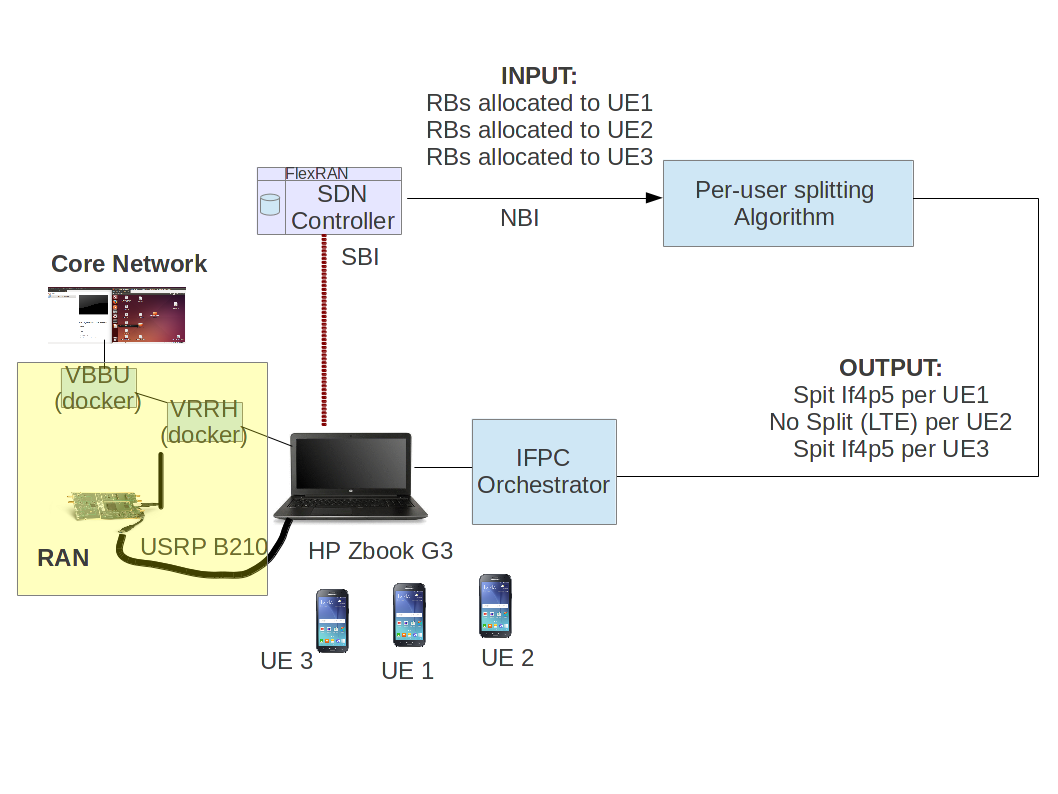On-demand Functional Split Prototype for C-RAN
Description:
We have designed a multi-sited C-RAN prototype, for enabling on-demand instantiation of Virtual RANs (V-RANs), by using lightweight virtualization techniques, e.g. Docker Container technology [1].
The goal of this prototype is to provide an user-friendly tool for testing RAN as a Service (RANaaS)[2] solutions for the upcoming 5G systems.
In particular, our prototype relies on an SDN-based architecture which aims at enabling the dynamically placement of baseband (BBU) functions either at the access site or cloud site of the C-RAN network architecture, according to the inputs of northbound applications and/or algorithms that deal with the dynamic splitting of C-RAN network functions.

Fig.1: C-RAN architecure
The logic architecture of our C-RAN prototype is shown in Fig. 1. It consists of an access site and an local cloud. The bottom layer consists of a set of USRP B210 cards [3], each of which is served by a data unit in the access site, forming the so-called RRU. The BBU functions are flexibly deployed between the access and the edge site and connected to the RRUs through a fronthaul link. Our prototype relies on the Open Air Interface (OAI) software [4] and adopts a Software Defiined Network (SDN) approach [5] to monitor and control the network state of the RAN, while employing the ETSI NFVI standard [6] for orchestrating the RRU-BBU functional splitting on-demand.
The details of the SDN-based logic approach of our prototype are shown in Fig.2. The RAN is interconnected to an SDN Controller, by means of a southbound interface (SBI). The role of that controller is to monitor the network state of the RAN, and trigger a northbound application, which we have developed for enabling flexible RRU-BBU functional splits, driven by the real-time network state (system load, radio conditions, resource capacity, etc.,).

Fig.2: SDN logic architecure
Goal:
The goal of our prototype is to configure in real time the splitting configuration of a C-RAN network according to inputs of an SDN northbound splitting application.
Uses Cases:
We have designed a multi-sited C-RAN prototype, for enabling on-demand instantiation of Virtual RANs (V-RANs), by using lightweight virtualization techniques, e.g. Docker Container technology [1].
The goal of this prototype is to provide an user-friendly tool for testing RAN as a Service (RANaaS)[2] solutions for the upcoming 5G systems.
In particular, our prototype relies on an SDN-based architecture which aims at enabling the dynamically placement of baseband (BBU) functions either at the access site or cloud site of the C-RAN network architecture, according to the inputs of northbound applications and/or algorithms that deal with the dynamic splitting of C-RAN network functions.

Fig.1: C-RAN architecure
The logic architecture of our C-RAN prototype is shown in Fig. 1. It consists of an access site and an local cloud. The bottom layer consists of a set of USRP B210 cards [3], each of which is served by a data unit in the access site, forming the so-called RRU. The BBU functions are flexibly deployed between the access and the edge site and connected to the RRUs through a fronthaul link. Our prototype relies on the Open Air Interface (OAI) software [4] and adopts a Software Defiined Network (SDN) approach [5] to monitor and control the network state of the RAN, while employing the ETSI NFVI standard [6] for orchestrating the RRU-BBU functional splitting on-demand.
The details of the SDN-based logic approach of our prototype are shown in Fig.2. The RAN is interconnected to an SDN Controller, by means of a southbound interface (SBI). The role of that controller is to monitor the network state of the RAN, and trigger a northbound application, which we have developed for enabling flexible RRU-BBU functional splits, driven by the real-time network state (system load, radio conditions, resource capacity, etc.,).

Fig.2: SDN logic architecure
Goal:
The goal of our prototype is to configure in real time the splitting configuration of a C-RAN network according to inputs of an SDN northbound splitting application.
Uses Cases:
- Virtual Mobile Network Operator (VMNO) Multi-tenancy: multiple V-RANs on the same shared network infrastructure
- Dynamic configuration of the V-RAN: CPU, Memory,power, resource allocation in real-time
- Dynamic Splitting Configuration in real-time for Virtual eNB
Demo: Dynamic
Splitting Prototype for C-RAN
In the following video we present a demo of our prototype. The aim of this demo is to show the feasibility of the prototype in handling the creation and configuration of C-RAN functional spltis on-demand, taking into account some inputs that are elaborated from an SDN-based application.
REFERENCES
- https://www.docker.com/
- D. Sabella et al., "RAN as a service: Challenges of designing a
flexible RAN architecture in a cloud-based heterogeneous mobile
network," 2013 Future Network & Mobile Summit, Lisboa, 2013.
- USRP B200/B210 Specification Sheet, avalaible online at https://www.ettus.com/product/details/UB200-KIT
- http://gitlab.eurecom.fr/oai/openairinterface5g/wikis/how-to-connectcots-ue-to-oai-enb-via-ngfi-rru
- X. Foukas, N. Nikaein, M. M. Kassem, M. K. Marina and K. Kontovasilis, FlexRAN: A Flexible and Programmable Platform for Software-Defined Radio Access Networks,ACM CoNEXT, California, USA, 12-15 Dec. 2016.
- "Network function virtualisation (NFV); reliability; report on the resilience of nfv-mano critical capabilities," ETSI GR NFV-REL 007 V1.1.2, Tech. Rep., October 2017.
- S. Matoussi, I. Fajjari, S. Costanzo, N. Aitsaadi and R. Langar, "Joint Functional Split and Resource Allocation in 5G Cloud-RAN", IEEE International Conference on Communications (ICC) 2019, Shanghai, China, 20-24 May 2019.
- S. Matoussi, I. Fajjari, S. Costanzo, N. Aitsaadi and R. Langar, "A User Centric Virtual Network Function Orchestration for Agile 5G Cloud-RAN", IEEE International Conference on Communications (ICC) 2018, Kansas City, MO, USA, 20-24 May 2018.
